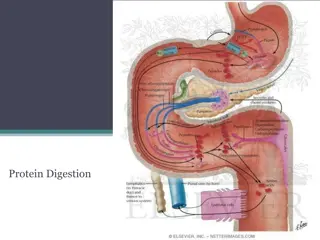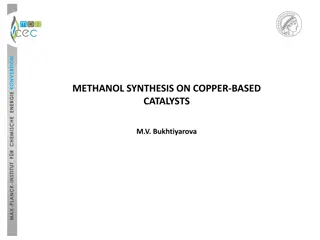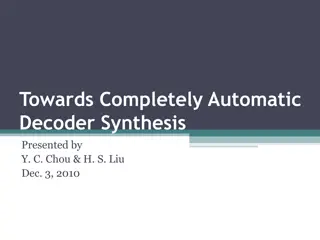Understanding Lipids: Properties, Functions, and Types
Lipids are a diverse group of organic compounds that include fats, oils, hormones, and components of cell membranes. They are vital for energy storage, structural roles in cell membranes, hormone synthesis, and organ protection. Lipids can be classified into different types such as waxes, triglyceri
11 views • 14 slides
Preparation of Aspirin: Overview and Synthesis Methods
The preparation of aspirin involves the synthesis of 2-acetyl salicylic acid, known for its therapeutic uses as an analgesic, antipyretic, and anti-inflammatory agent. This process includes the detailed characteristics, stability, mechanism, and synthesis methods of aspirin. Important considerations
1 views • 12 slides
Acetaminophen Synthesis Process Explained
Acetaminophen, also known as paracetamol, is a widely used analgesic and fever-reducing medicine. The synthesis of acetaminophen involves treating an amine with an acid anhydride to form an amide. This process includes mixing reactants, isolating crude acetaminophen, and purifying the final product.
0 views • 17 slides
Industrial Production of Citric Acid: Fermentation Processes and Applications
Citric acid is industrially produced through microbial fermentation processes. It is widely used in various industries such as food, pharmaceuticals, and beverage production. Different methods like surface culture fermentation are employed for citric acid manufacture, with fungi like Aspergillus nig
4 views • 18 slides
Innovative Development in High Stearic Acid Soybean Germplasm Breeding at University of Missouri Delta Center
Innovative research on developing high stearic acid soybean germplasm is being conducted at the University of Missouri Delta Center. Challenges in breeding high stearic soybeans, such as sodium azide-induced deletions and mutant alleles in SACPDs, are being addressed. Promising lines identified from
1 views • 9 slides
Limit Test of Iron Based on Color Reaction with Thioglycollic Acid
The limit test for iron involves the reaction of iron in ammoniacal solution with citric acid and thioglycollic acid to form a reddish-purple color. By comparing the color produced with a standard solution, the presence of iron is determined. Citric acid prevents precipitation of iron, while thiogly
1 views • 5 slides
Determination of Acetic Acid Content in Vinegar Experiment
The experiment aims to measure the total acid concentration in a specific brand of vinegar through a titration process using NaOH solution. The procedure involves titrating the vinegar solution with NaOH until a pink color appears, calculating the concentration of acetic acid, and determining the pe
3 views • 8 slides
Overview of Heme Synthesis and Porphyrias
Heme is a crucial component present in various essential proteins in the body, such as hemoglobin, myoglobin, and cytochromes. The synthesis of heme takes place in multiple steps involving different organelles and enzymes in the cell. Porphyrias are a group of disorders related to heme synthesis, ch
1 views • 44 slides
Understanding Protein Digestion and Amino Acid Metabolism
The process of protein digestion involves proteolytic enzymes produced by the stomach, pancreas, and small intestine. Pepsinogen is activated to pepsin in the stomach, breaking down proteins into oligopeptides and amino acids. After absorption, amino acids are utilized for protein synthesis and as d
0 views • 7 slides
Synthesis of Acetylcysteine: Procedure, Uses, and Precautions
The synthesis of acetylcysteine involves acetylating L-Cysteine in the presence of acetic anhydride and sulfuric acid. Acetylcysteine has various uses, including reducing pulmonary secretions' viscosity, being an antidote for acetaminophen overdose, and chelating heavy metals. The procedure, precaut
0 views • 20 slides
Overview of Glycine Metabolism and Its Importance in the Body
Glycine, the simplest amino acid, plays a crucial role in various metabolic pathways in the body. It can be converted to important compounds like pyruvic acid, lactic acid, and creates the one-carbon pool. Glycine is essential for heme synthesis, glutathione formation, purine synthesis, and more. In
8 views • 19 slides
Synthesis of Salicylic Acid: Theory, Derivatives, and Applications
Salicylic acid is synthesized from methyl salicylate through ester hydrolysis with aqueous alkali. It is a versatile compound used in organic synthesis, as a plant hormone, and derived from salicin metabolism. The derivatives of salicylic acid can minimize gastric disturbances and enhance therapeuti
4 views • 12 slides
Mechanism of Action of Antifolate Drugs in Bacterial Synthesis
Folate-derived cofactors are crucial for cell growth, with bacteria relying on de novo synthesis while humans need preformed folate. Antifolates like sulfonamides and trimethoprim disrupt folate synthesis in bacteria, inhibiting DNA synthesis. This article explores how these drugs target bacterial e
0 views • 34 slides
Overview of Salicylic Acid and its Derivatives
Salicylic acid is known for its antiseptic, germicidal, and analgesic properties, used in various applications such as preservatives, wart treatments, and pain relief. Different derivatives of salicylic acid are developed to minimize side effects and enhance efficacy. Acetyl salicylic acid (ASA), co
0 views • 15 slides
Understanding the Role of Starter Culture in Fermented Milk Products
Starter cultures play a crucial role in the production of fermented milk products by producing antimicrobial compounds like organic acids, H2O2, CO2, aroma compounds, fatty acids, and bacteriocins. These compounds help prevent spoilage by inhibiting the growth of harmful bacteria and altering cellul
6 views • 9 slides
Understanding Fatty Acids and Derived Lipids
Explore the world of fatty acids and derived lipids through detailed images and descriptions. Learn about the chemical structure, composition, and various types of fatty acids found in the human body. Discover how fatty acids are essential components of lipid forms and play a crucial role in biologi
0 views • 154 slides
Understanding Lipids: Properties, Functions, and Structure
Lipids are diverse organic compounds vital for metabolism and cell functions. They are insoluble in water, serve as energy sources, aid in hormone synthesis, and form cell membranes. Fatty acids, the building blocks of lipids, provide fuel for the body. Saturated fatty acids have high melting points
0 views • 44 slides
SAT-Based Exact Synthesis Using DAG Topology Families
Explore the world of exact synthesis in digital circuit design utilizing SAT solvers to achieve precise results. Understand the challenges, decision problems, algorithms, motivation behind exact synthesis, and the contribution of SAT solvers in mitigating runtime. Discover the concept of DAG topolog
0 views • 17 slides
Insights into Biological Synthesis Techniques and Related Work
Explore the biological synthesis project by Sumay and Sumit Gulwani at MSR Redmond. The project delves into template-based approaches and safety considerations in artifact synthesis. The outline covers inductive synthesis, challenges, and successes in achieving synthesis goals. Discover unique namin
0 views • 15 slides
Understanding Fatty Acid Metabolites Pathways and Functions
This article explores the complex biochemical pathways involved in the metabolism of fatty acids and their conversion into various metabolites. Fatty acid metabolites play essential roles in cellular energy production, signaling, and structural funct
0 views • 9 slides
Understanding the Health Effects of Coconut Oil
Coconut oil, derived from mature coconuts, is rich in saturated fats and widely used in food, medicine, and industry. Fatty acids play crucial roles in human health, with different types impacting metabolism differently. Coconut oil's unique fatty acid composition sets it apart from oils like corn o
0 views • 18 slides
Understanding Fats and Oils: Properties and Formation
Learn about the properties of fats and oils, including their formation through a condensation reaction of glycerol with fatty acids. Explore the role of fats in the diet, different types of natural fats and oils, and the chemical composition of triglycerides. Discover the significance of fatty acids
0 views • 17 slides
Understanding Fatty Acid Oxidation in Zoology Department with Miss Punam Patil
Explore the process of fatty acid oxidation in zoology, including the entry of fatty acids into mitochondria, TCA cycle outcomes, and differences between mitochondrial and peroxisomal oxidation. Learn about the oxidation of saturated, monounsaturated, and polyunsaturated fatty acids through detailed
0 views • 9 slides
Automated Program Synthesis and Application in Game Programming
Exploring program synthesis as a method for automatic program construction to meet high-level specifications, focusing on applications in game programming. Discusses concepts like Church Synthesis, Computation Tree Logic (CTL), and real-life examples like Tic-Tac-Toe game strategy synthesis. Explore
0 views • 7 slides
Understanding Purine Degradation and Gout
Purine degradation pathway involves the breakdown of dietary nucleic acids, mainly from meat, into uric acid through specific enzymatic steps. Excessive uric acid production can lead to conditions like gout and hyperuricemia. Humans excrete uric acid in the urine as the final product, while other an
1 views • 12 slides
Fatty Acids Profile and Health Lipid Indices of Tiger Shrimps
Seafood lipids, including Tiger shrimps like Peaneus monodon, are rich in essential fatty acids such as EPA, DHA, and AA. This study focuses on the fatty acids profile, atherogenic (IA), and thrombogenic (IT) health lipid indices of fresh and sundried Tiger shrimps, shedding light on the effects of
0 views • 19 slides
Automated String Processing in Spreadsheets: Innovations and Applications
Automating string processing in spreadsheets is gaining traction due to advancements in program synthesis technology. This field enables the generation of algorithms and programs from logic and examples, benefitting algorithm designers, software developers, and end-users alike. Synthesis techniques
0 views • 22 slides
Understanding the Pentose Phosphate Pathway in Metabolism
The Pentose Phosphate Pathway, also known as the Hexose Monophosphate shunt, is an alternative route for glucose metabolism that plays a crucial role in NADPH synthesis, fatty acid production, antioxidant activity, and nucleotide formation. This pathway involves oxidative and non-oxidative phases, r
0 views • 12 slides
Methanol Synthesis on Copper-Based Catalysts at Max Planck Institut
Methanol production using synthesis gas, studying CO2 hydrogenation for reduced CO2 emissions, and utilizing methanol as a hydrogen storage method are key areas of focus at the Max Planck Institut for Chemical Energy Conversion. The process involves methanol synthesis from CO2 and H2, with experimen
0 views • 19 slides
Advances in Completely Automatic Decoder Synthesis
This presentation by Y.C. Chou and H.S. Liu on "Towards Completely Automatic Decoder Synthesis" covers topics such as motivation, preliminary concepts, main algorithms, and experimental results in the field of communication and cryptography systems. The content delves into notation, SAT solvers, Cra
0 views • 35 slides
Common Organic Acids and Their Uses in Various Industries
Citric acid, lactic acid, salicylic acid, and tartaric acid are natural acids found in various fruits. They have diverse applications in food and beverage, pharmaceutical, and cosmetic industries. These acids are used for flavoring, cleaning, as food additives, and in the preparation of various prod
0 views • 4 slides
Synthesis of Banana Oil in Chemistry Class
The synthesis of banana oil involves a reaction between carboxylic acid and alcohol catalyzed by H2SO4 to produce isoamyl acetate. The mechanism includes nucleophilic acyl substitution with two main reaction steps - addition and elimination. The process shifts the equilibrium to favor product format
0 views • 16 slides
Polyglycerol Esters of Fatty Acids: Key to Enhanced Product Stability
Polyglycerol esters of fatty acids (PGE) are versatile, natural emulsifiers used widely in food, cosmetics, and pharmaceuticals. At Spell Organics, we harness Polyglycerol Esters of Fatty Acids to elevate product stability, consistency, and shelf lif
0 views • 11 slides
Understanding Purine Nucleotide Synthesis in Molecular Biology
The process of Purine Nucleotide Synthesis involves the formation of purine ribonucleotides, breakdown into uric acid, and the detailed steps of purine nucleotide synthesis. Key components like IMP, SAICAR, PRPP, and ATP play crucial roles in this complex metabolic pathway, offering insights into th
0 views • 22 slides
Understanding Serum Uric Acid Levels and Hyperuricemia
Serum uric acid is a crucial marker of purine metabolism, with elevated levels indicating hyperuricemia which can lead to conditions like Gout. The measurement of serum uric acid helps in diagnosing hyperuricemia, with serum being the preferred specimen for testing. Various factors such as diet, gen
0 views • 12 slides
Qualitative Tests of Lipids and Derived Lipids Overview
Qualitative tests of lipids distinguish between oil, neutral fat, saturated fatty acids, and unsaturated fatty acids using methods like the copper acetate test. Derived lipids include substances like cholesterol and fat-soluble vitamins that are either soluble in lipids or derived from lipids throug
0 views • 14 slides
Omega 7 in Sea Buckthorn: The Rare Fatty Acid with Surprising Health Benefits
Omega 7 is a rare and beneficial fatty acid that is gaining attention for its potential health advantages. While Omega 3, 6, and 9 are well-known for their benefits, Omega 7, especially found in sea buckthorn, holds unique properties that support ove
0 views • 8 slides
Understanding Model-Based Projection Synthesis Theory and Practice
Explore the theory and practical application of Model-Based Projection Synthesis (MBP) in solving problems related to quantifier elimination, validity of first-order logic fragments, and witness synthesis. Learn about solving existential quantifier sentences and extracting witnesses in the context o
0 views • 56 slides
Understanding Fatty Acid Metabolism in Animals
Animals cannot convert fatty acids into glucose due to the inability to synthesize glucose from fatty acids. The process involves acetyl-CoA not being converted into pyruvate or oxaloacetate, leading to the citric acid cycle and differences between fatty acid synthesis and degradation pathways. Key
0 views • 8 slides
Fatty Liver and Kidney Syndrome (FLKS) in Poultry: Causes and Symptoms
Fatty Liver and Kidney Syndrome (FLKS) is a nutritional deficiency disease in poultry characterized by the accumulation of fat in the liver and kidneys. This syndrome can lead to morbidity and mortality in affected chickens, with symptoms like incoordination and abnormal movements. The liver and kid
0 views • 20 slides







































